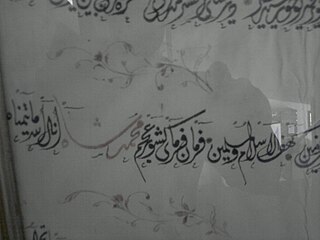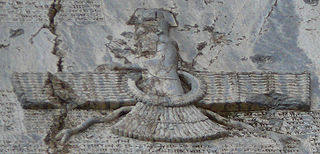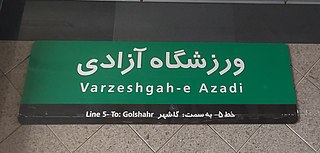
Persian, also known by its endonym Farsi, is a Western Iranian language belonging to the Iranian branch of the Indo-Iranian subdivision of the Indo-European languages. Persian is a pluricentric language predominantly spoken and used officially within Iran, Afghanistan, and Tajikistan in three mutually intelligible standard varieties, namely Iranian Persian, Dari Persian, and Tajiki Persian. It is also spoken natively in the Tajik variety by a significant population within Uzbekistan, as well as within other regions with a Persianate history in the cultural sphere of Greater Iran. It is written officially within Iran and Afghanistan in the Persian alphabet, a derivative of the Arabic script, and within Tajikistan in the Tajik alphabet, a derivative of the Cyrillic script.
The Persians are an Iranian ethnic group who comprise over half of the population of Iran. They share a common cultural system and are native speakers of the Persian language as well as of the languages that are closely related to Persian.

The Medes were an ancient Iranian people who spoke the Median language and who inhabited an area known as Media between western and northern Iran. Around the 11th century BC, they occupied the mountainous region of northwestern Iran and the northeastern and eastern region of Mesopotamia in the vicinity of Ecbatana. Their consolidation in Iran is believed to have occurred during the 8th century BC. In the 7th century BC, all of western Iran and some other territories were under Median rule, but their precise geographic extent remains unknown.

Azerbaijani or Azeri, also referred to as Azeri Turkic or Azeri Turkish, is a Turkic language from the Oghuz sub-branch. It is spoken primarily by the Azerbaijani people, who live mainly in the Republic of Azerbaijan where the North Azerbaijani variety is spoken, and in the Azerbaijan region of Iran, where the South Azerbaijani variety is spoken. North Azerbaijani has official status in the Republic of Azerbaijan and Dagestan, but South Azerbaijani does not have official status in Iran, where the majority of Azerbaijani people live. Azerbaijani language is also spoken to lesser varying degrees in Azerbaijani communities of Georgia and Turkey and by diaspora communities, primarily in Europe and North America.

Tajik, also called Tajiki Persian or Tajiki, is the variety of Persian spoken in Tajikistan and Uzbekistan by Tajiks. It is closely related to neighbouring Dari of Afghanistan with which it forms a continuum of mutually intelligible varieties of the Persian language. Several scholars consider Tajik as a dialectal variety of Persian rather than a language on its own. The popularity of this conception of Tajik as a variety of Persian was such that, during the period in which Tajik intellectuals were trying to establish Tajik as a language separate from Persian, prominent intellectual Sadriddin Ayni counterargued that Tajik was not a "bastardised dialect" of Persian. The issue of whether Tajik and Persian are to be considered two dialects of a single language or two discrete languages has political sides to it.

Semnan province is one of the 31 provinces of Iran. It is in the north of the country, with its center and capital in the city of Semnan. The province of Semnan covers an area of 96,816 square kilometers and stretches along the Alborz mountain range, bordering on Kavir desert in its southern parts.

Ajam is an Arabic word meaning mute. It generally refers to someone whose mother tongue is not Arabic, as well as non-Arabs. During the Arab conquest of Persia, the term became a racial pejorative. In many languages, including Persian, Turkish, Urdu–Hindi, Azerbaijani, Bengali, Kurdish, Gujarati, Malay, Punjabi, and Swahili, Ajam and Ajami refer to Iran and Iranians respectively.
The mass media in Iran is both privately and publicly owned but all channels are subject to censorship. In 2016, Iran had 178 newspapers, 83 magazines, 15,000 information sites and 2 million blogs. A special court has authority to monitor the print media and may suspend publication, or revoke the licenses, of papers or journals that a jury finds guilty of publishing anti-religious or slanderous material or information detrimental to the national interest. The Iranian media is prohibited from criticizing Islamic doctrine.
Judeo-Hamadani and Judeo-Borujerdi constitute a Northwestern Iranian language, originally spoken by the Iranian Jews of Hamadan and Borujerd in western Iran. Hamadanis refer to their language as ebri “Hebrew” or zabān-e qadim “old language.” Though not Hebrew, the term ebri is used to distinguish Judeo-Hamadani from Persian.
In 1920, Hamadan had around 13,000 Jewish residents. According to members of the community that Donald Stilo encountered in 2001-02, there were only eight people from the Jewish community left in Hamadān at the time, but others can still be found in Israel, New York City, and most predominantly in Los Angeles.
Judeo-Shirazi is a variety of Fars. Some Judeo-Shirazi speakers refer to the language as Jidi, though Jidi is normally a designation used by speakers of Judeo-Esfahani. It is spoken mostly by Persian Jews living in Shiraz and surrounding areas of the Fars Province in Iran.
In the Western world, Persia was historically the common name used for Iran. On the Nowruz of 1935, Reza Shah officially asked foreign delegates to use the Persian term Iran, the endonym of the country, in formal correspondence. Subsequently, the common adjective for citizens of Iran changed from Persian to Iranian. In 1959, the government of Mohammad Reza Pahlavi, Reza Shah's son, announced that both "Persia" and "Iran" could be used interchangeably, in formal correspondence. However, the issue is still debated among Iranians.
The Parthian language, also known as Arsacid Pahlavi and Pahlawānīg, is an extinct ancient Northwestern Iranian language once spoken in Parthia, a region situated in present-day northeastern Iran and Turkmenistan. Parthian was the language of state of the Arsacid Parthian Empire, as well as of its eponymous branches of the Arsacid dynasty of Armenia, Arsacid dynasty of Iberia, and the Arsacid dynasty of Caucasian Albania.

The Iranian languages, alternately called the Iranic languages, are a branch of the Indo-Iranian languages in the Indo-European language family that are spoken natively by the Iranian peoples, predominantly in the Iranian Plateau.

Greater Iran or Greater Persia, also known as Persosphere, is a sociocultural region in which Iranian traditions and Iranian languages have had a significant impact. It spans parts of West Asia, the Caucasus, Central Asia, South Asia, and parts of East Asia, specifically Xinjiang, China. The region is defined by having been long-ruled by the dynasties of various Iranian empires, under whom the local populaces gradually incorporated some degree of Iranian influence into their cultural and/or linguistic traditions; or alternatively as where a considerable number of Iranian peoples settled to still maintain communities who patronize their respective cultures, geographically corresponding to the areas surrounding the Iranian plateau. It is referred to as the "Iranian Cultural Continent" by Encyclopædia Iranica.

Iranian studies, also referred to as Iranology and Iranistics, is an interdisciplinary field dealing with the research and study of the civilization, history, literature, art and culture of Iranian peoples. It is a part of the wider field of Oriental studies.

Proto-Iranian or Proto-Iranic is the reconstructed proto-language of the Iranian languages branch of Indo-European language family and thus the ancestor of the Iranian languages such as Persian, Pashto, Sogdian, Zazaki, Ossetian, Mazandarani, Kurdish, Talysh and others. Its speakers, the hypothetical Proto-Iranians, are assumed to have lived in the 2nd millennium BC and are usually connected with the Andronovo archaeological horizon.

Romanization or Latinization of Persian is the representation of the Persian language with the Latin script. Several different romanization schemes exist, each with its own set of rules driven by its own set of ideological goals.

Imam Khomeini International University (IKIU), informally Qazvin International University, is an international university in Iran that was founded after the Islamic Revolution. The bill of IKIU’s constitution was ratified by the Iranian Parliament in January 1984. Constituent organs of IKIU include Board of trustees, president, and council. Deputies for Education, Research, and Students and Culture are some of the other departments. In addition, there is a Science and Technology Park, and central library with more than 100000 books and magazines.











